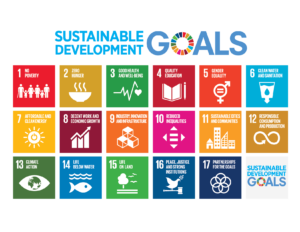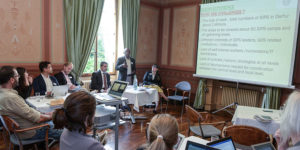Ever since a week full of international meetings on indicator frameworks at the end of March 2019, I am left reflecting on the issue of statistical capacity building, or more specifically on capacity building to improve data on forced displacement.
Data – or statistics – is a critical building block to improve response in displacement crises and to enable real progress on international commitments and measure our success in doing so. Yet time and again, voices cry out for capacity development to help make this a reality and we all know there are no quick fixes to this. Especially when it comes to challenging data subjects, such as forced displacement.

The 17 Sustainable Development Goals (SDGs).
Attending, in an observer capacity, recent meetings of the Inter-Agency and Expert Group on Sustainable Development Goal Indicators (IAEG-SDGs, see our article on the 8th meeting and the event page on its 9th meeting) and the first preparatory meeting for the 2019 Global Refugee Forum, this conundrum became apparent.
“Ensuring that commitments [to realise the 2030 Agenda for Sustainable Development] are translated into effective action requires a precise understanding of the target populations and progress made in addressing their particular priorities.”
(IAEG-SDGs’ background document from March 2019)
The aspiration of the 2030 Agenda to “leave no-one behind” is reflected in the monitoring efforts of countries and the work of the IAEG-SDGs, primarily through the provision of disaggregated data. Because without being able to ‘see’ vulnerable groups in our data, how can we effectively include them in development programming and give them the attention they deserve?
This commitment is cemented in the 2030 Agenda itself, but it is also integrated into the indicator framework with a number of indicators and targets directly referencing specific population groups, whether by sex, age, disability status, location (urban/rural), employment status, etc. Furthermore, through the IAEG-SDGs efforts on data disaggregation in collaboration with custodian agencies and various multi-stakeholder constituencies, the level of ambition extends beyond what has been included in the framework explicitly.
Migrants and forcibly displaced persons are specifically mentioned in the 2030 Agenda (“migratory status”) and have been integrated into the disaggregation workstream based on efforts of two Expert Groups: the Expert Group Meeting on Improving Migration Statistics in the context of the 2030 Agenda for Sustainable Development , and the Expert Group on Refugee and IDP Statistics (EGRIS).
However, the call for inclusion of these groups, particularly when it comes to refugees and IDPs, is quickly met with the very real challenges related to limited capacity and over-burdened statistical systems.

At our conference “Making Data Useful” in 2017, we dedicated a full session to the topic of sustainability and local capacity building. Read about the discussion points in our report.
In a similar vein, at the first preparatory meeting for the Global Refugee Forum on the 29th March, 2019, the same concern became apparent through the discussion around indicators to measure progress on implementing the Global Compact on Refugees (GCR).
Many of these concerns are of course well-placed and well-recognised. Strengthening statistics on populations who, in many contexts, are not currently included in national statistical systems is already a tall order. Add onto that the various operational, technical and political hurdles that are common in displacement settings as well as the wider context regarding the already heavy demands of statistical offices, the ambition starts to look more like an aspiration rather than an achievable goal.
It is widely recognised that making effective use of the SDG monitoring framework requires strengthening national statistical capacities and building new ones, as well as developing relevant standards and tools (IAEG-SDGs’ background document from March 2019). This will be helpful to generate high quality data that can inform effective action as well as enable monitoring of progress against both the SDGs and the GCR objectives.
“The data demands of the SDGs are requiring countries to ramp up capacity within their national statistical systems.” (Paris 21)
However, capacity building takes significant and sustained political will, mutual interest, technical cooperation, donor support and time. It requires long-term investment and cooperation. Given that it is notoriously difficult to measure its impact and therefore justify and refine continued engagement over time, statistical capacity building does not always attract the attention it needs.
In addition, while capacity building is difficult enough to realise on mainstream, uncontroversial topics, it becomes all the more challenging when the data in question relates to population groups or socioeconomic phenomena that are inherently sensitive in nature – such as forced displacement.
There are of course various efforts underway that focus on building statistical capacity in the framework of the SDGs – such as UNSD’s programmes, Paris 21, the Dubai Declaration and various regional and bilateral initiatives. There are also some specific initiatives that focus on statistics of refugees and IDPs or are making dedicated efforts to integrate these population groups into broader programmes, including:
Enhanced efforts, however, are needed – and fast – to help join the dots between broader statistical capacity building efforts and those focused on the inclusion of forcibly displaced persons in national statistics. This will in turn benefit inclusion of forced displacement in the SDGs and monitoring the progress against the GCR objectives.
At JIPS we are working in various ways to contribute to these efforts, under the third goal of our 2018-2020 strategy. Besides our involvement in the EGRIS as lead of the sub-working group on IDP statistics and our contribution to the IAEG-SDGs meetings, we also invest in capacity building through our field support, often working closely with statistical offices and systems in displacement-affected countries and regions (e.g. Iraq, Honduras, El Salvador, Colombia, Kosovo, but also in new exercises such as in Nigeria).
We also encourage participation of national statisticians in our global and regional trainings (e.g. from Colombia, Libya, Cameroon and Tchad in PCTs). For fall 2019, we are also planning to host a conference on the subject to bring key stakeholders together and outline recommendations.
—
Want to know more about the Expert Group on Refugee and IDP Statistics (EGRIS) or other efforts JIPS has joined to reinforce partners’ statistical capacities? Get in touch with us at info@jips.org, or visit our pages on Facebook, LinkedIn or Twitter.